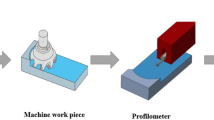Abstract
Machinability aspect is of paramount importance for efficient process planning in manufacturing. Machinability of work materials is an imperative aspect which may affect the different manufacturing phases including product design, process planning and machining operation. Machinability of engineering materials may be evaluated in terms of process output variables like surface roughness (SR), material removal rate, cutting forces etc. CNC milling has become one of the most competent, productive and flexible manufacturing methods, for complicated or sculptured surfaces. With the more precise demands of modern engineering products, the control of surface texture has become more important. This paper reports mathematical model for correlating the milling machining parameters such as spindle speed, table feed rate, depth of cut, step over and coolant pressure, with the response characteristic, SR, while machining hot die steel, H-11 with titanium coated carbide end mill cutter. The response surface methodology in conjunction with face centered central composite rotatable design has been used to develop the empirical model for the response. The significance of the mathematical model developed was ascertained using desirability functions and confirmation experiments. The results obtained depict that the mathematical model is useful not only for predicting optimal process parameters for achieving the desired quality but also for achieving the process optimization.














Similar content being viewed by others
References
Aggarwal A, Singh H, Kumar P (2009) Simultaneous optimization of conflicting responses for CNC turned parts using desirability function. Int J Manuf Technol Manag 18:319–332
Alauddin M, Baradie EI (1997) Tool life model for end milling steel (190 BHN). JOMPT 68:50–59
Altintas Y (1994) Direct adaptive control of end milling process. Int J Mach Tools Manuf 34:461–472
Ding TC, Zhang S, Wang YW, Zhu XL (2010) Empirical models and optimal cutting parameters for cutting forces and surface roughness in hard milling of AISI H13 steel. Int J Adv Manuf Technol 51:45–55
Dweiri F, Al-Jarrah M, Al-Wedyan H (2003) Fuzzy surface roughness modeling of CNC down milling of Alumic-79. JOMPT 133:266–275
Ezugwu EO (2005) Key improvements in the machining of difficult-to-cut aerospace superalloys. Int J Mach Tool Manuf 45((12/13)):1353–1367
Fnides B, Aouici H, Yallese MA (2008) Cutting forces and surface roughness in hard turning of hot work steel X38CrMoV5-1 using mixed ceramic. Int J Sci Res 70:73–78
Gologlu C, Sakarya N (2008) Effect of cutter path strategies of surface roughness of pocket milling of 1.2738 steel based on Taguchi method. JOMPT 206:7–15
Horng JT, Liu NM, Chiang KT (2008) Investigating the machinability evaluation of hadfield steel in the hard turning with ceramic tool based on the response surface methodology. JOMPT 208:532–554
Jangra K, Grover S, Chan TS (2002) Digraph and matrix method to evaluate the machinability of tungsten carbide composite with wire EDM. Int J Adv Manuf Tech 56:959–974
Jindal PC, Santhanam AT, Shuster FA (1999) Performance of PVD TiN, TiCN and TiAlN coated cemented carbide tools in turning. Int J Refract Met Hard Mater 17:163–170
Kadirgama K, Hamdi M, Benyounis KY (2007) Prediction of cutting force in end-milling operation of modified AISI P20 tool steel. JOMPT 182:241–247
Kim DH, Lee CM (2014) A study of cutting force and preheating temperature prediction for laser assisted milling of Inconel 718 & AISI 1045 steel. Int J of Heat Mass Transf 71:264–274
Lee HW, Kwon WT (2010) Determination of minute range for RSM to select the optimum cutting conditions during turning on CNC lathe. Int J Mech Sci Technol 24:1637–1645
Li ZZ, Cheng TH, Xuan DJ (2012) optimal design for cooling system of batteries using DOE and RSM. Int J Precis Eng. Manuf 13:1641–1645
Lou MS, Chen JC, Caleb M (1999) Surface roughness prediction technique for CNC end milling. J Ind Technol 15:1–6
Mini Tab Release 14 reference manual. (2004) Minitab Inc., USA
Montgomery DC (2005) Design and analysis of experiments. Wiley, New York
Montgomery DC, Peck EF (2005) Introduction to linear regression analysis. Wiley, New York
Muhammad N, Manurung YHP, Hafidzi M, Abas SK, Than G, Haruman E (2012) Optimization and modeling of spot welding parameters with simultaneous multiple response consideration using multi-objective Taguchi method and RSM. Int J Mech Sci Technol 26:2365–2370
Oktem H, Kurtaran H (2005) Application of RSM in optimization of cutting conditions for surface roughness. JOMPT 170:11–16
Rao RV, Gandhi OP (2002) Digraph and matrix methods for the machinability evaluation of work materials. Int J Mach Tools Manuf 42:321–330
Saini S, Ahuja S, Sharma VS (2012) Influence of cutting parameters on tool wear and surface roughness in hard turning of AISI H11 tool steel using ceramic tools. Int J Precis Eng Manuf 13:1295–1302
Siller HR, Vila C, Rodríguez CA, Abellán JV (2009) Study of face milling of hardened AISI D3 steel with a special design of carbide tools. Int J Adv Manuf Technol 40:12–25
Toh CK (2006) Cutter path orientations when high-speed finish milling inclined hardened steel. Int J AdvManuf Technol 27:473–480
Trent EM (1998) Metal cutting, 2nd edn. Butterworths, London, p 172
Tsai YH, Chen JC (1999) In process surface recognition system based on neural networks in end milling cutting operation. Int J Mach Tools Manuf 39:583–605
Tzeng YF (2007) A hybrid approach to optimize multiple performance characteristics of high speed computerized numerical control milling tool steels. Mater Des 28:36–46
Yang RT, Liao HT, Yang YK, Lin SS (2012) Modeling and optimization in precise boring processes for aluminium alloy 6061T6 components. Int J Precis Eng Manuf 13:11–16
Zhang JZ, Chen JC, Kirby ED (2007) Surface roughness optimization in an end milling operation using Taguchi design method. JOMPT 184:233–239
Author information
Authors and Affiliations
Corresponding author
Rights and permissions
About this article
Cite this article
Chahal, M., Singh, V. & Garg, R. Optimum surface roughness evaluation of dies steel H-11 with CNC milling using RSM with desirability function. Int J Syst Assur Eng Manag 8, 432–444 (2017). https://doi.org/10.1007/s13198-016-0446-y
Received:
Revised:
Published:
Issue Date:
DOI: https://doi.org/10.1007/s13198-016-0446-y




